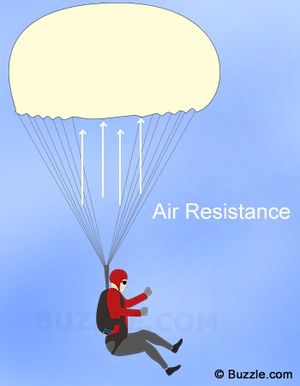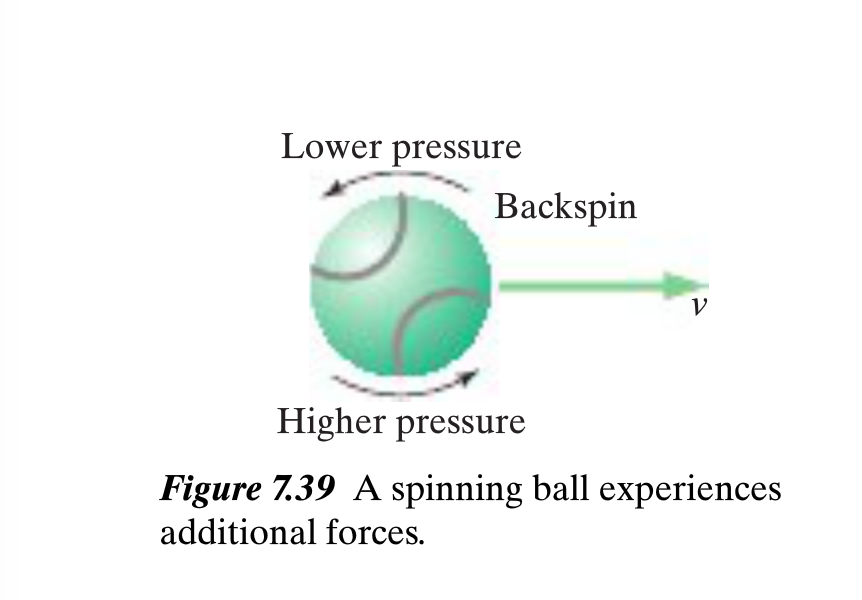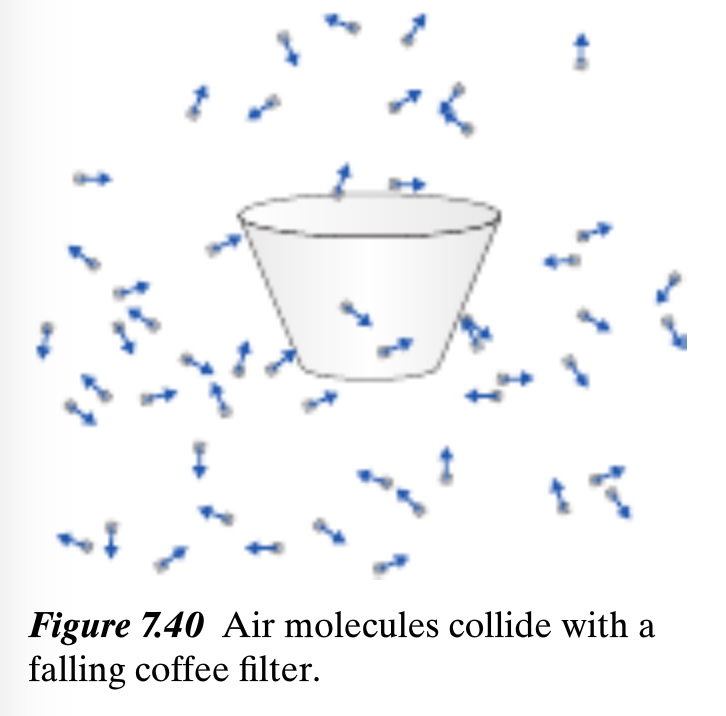Air Resistance
Main Idea

When an object moves through a fluid (gas or liquid), forms of friction called air resistance, viscosity, and drag oppose the direction of motion of the object. Air resistance is one of the most common types of these oppositional forces. Its effects must be taken into account with any form of flight (space ships, airplanes, rockets, missiles). The drag force is a means of energy dissipation, where energy is converted into a non useful form, thermal energy.
The amount of air resistance is related to quite a few factors, such as cross sectional area, relative speed, and density.
Mathematical Model
A typical drag force can be described by:
- [math]\displaystyle{ F_{D} = \frac{1}{2}\rho v^2 A C_{D} }[/math], where
- [math]\displaystyle{ \rho = }[/math] the density of the fluid being passed through
- [math]\displaystyle{ v = }[/math] the speed of the object relative to the fluid
- [math]\displaystyle{ A }[/math] is the cross-sectional area of the object
- [math]\displaystyle{ C_{D} = }[/math] a dimensionless drag coefficient
Cross Sectional Area
We have encountered the term of 'cross-sectional area' in many cases: for example, when you need to calculate the flux of a liquid flowing through a pipe, you need the cross-sectional area to determine the volume of the liquid flowing through. However, the 'cross-sectional area' here is different. We'd better see it as the 'frontal area': the area facing the direction of the object's movement.
It is easy to understand: we can relate this idea to the choice of the system and moving objects. For example, when a plane is flying forward with a speed [math]\displaystyle{ v }[/math] in the [math]\displaystyle{ +x }[/math] direction and the air is static, only the surface of the plane pointing in the [math]\displaystyle{ +x }[/math] direction is subject to the air resistance, since most air particles are colliding with that area with relatively high speed in the opposite direction.
Computational Model
- Insert Computational Model here
Examples
Simple
Middling
Difficult
Connectedness
History
Aristotle was the first to write about air resistance in the 4th century BC. In the 15th century, Leonardo da Vinci published the Codex Leicester, in which he rejected Aristotle's theory and attempted to prove that the only effect of air on a thrown object was to resist its motion. The first equation for air resistance was:
- [math]\displaystyle{ F_{D} = \rho S V^2 \text{sin}^2(\theta) }[/math]
This equation overestimates drag in most cases, and was often used in the 19th century to argue the impossibility of human flight.
Louis Charles Breguet's paper in 1922 began efforts to reduce drag by streamlining. A further major call for streamlining was made by Sir Melvill Jones who provided the theoretical concepts to demonstrate emphatically the importance of streamlining in aircraft design. The aspect of Jones’s paper that most shocked the designers of the time was his plot of the horse power required versus velocity, for an actual and an ideal plane.
See also
Further reading
External links
References
Variables and constants
As you can see in the picture above, air resistance in positively correlated to the density of the air, the cross-sectional area of the object, the square of the velocity, and the coefficient of air resistance, or 'drag coefficient.'
Types Of Air Resistance
There are three main types of drag in aerodynamics – Lift Induced, Parasitic, and Wave. Each affects an object's ability to stay in the air as well as the requirements to keep it there.
Rotational Motion on Air Resistance
If a ball has spin, there is an effect of fluid flow around the ball that raises the air pressure on the side where the rotational motion is in the same direction as the ball's velocity, and lowers the air pressure on the other side, where the rotational motion is in the opposite direction to the velocity. In the figure above, the force points upward due to "backspin" and lifts the ball extending the range. In the case where there is topspin on the ball, the force is downward decreasing the range. This topic is related to fluid dynamics.
Examples
Problem 1
You are standing at the top of a 20 meters high building. You throw a ball with an initial speed of 10 m/s in +x direction. If you neglect air resistance, where would you expect the ball to hit on the plain surface below? Do you think your prediction without air resistance is too large or too small?
Solution:
height = (initial velocity in y direction)(time) + .5(gravitational acceleration)(time)^2
Since the initial velocity in the y direction equals 0, we can simplify it as:
height = .5(gravitational acceleration)(time)^2
20 = .5(9.8)(t)^2
Solve for t.
t = 2.02 seconds
range = (initial velocity in x direction)(time) + .5(acceleration in x direction)(time)^2
Since there is no acceleration in the x direction, the equation is just:
range = (initial velocity in x direction)(time)
range = (10)(2.02)
range = 20.2 meters
Our prediction without air resistance is too large, because air resistance has a force opposite to motion. This in turn would make the landing distance shorter.
Problem 2
John is going sky diving for the first time. His mass is 70 kg and his terminal speed is 38 m/s. What is the magnitude of the force of the air on John?
Solution:
At the terminal speed, the force of air (air resistance) is equal to the force of gravity.
Force air = Force gravity
Force air = (mass) (acceleration from gravity)
Force air = (70)(9.8)
Force air = 686 Newtons
Follow-up question: How can we decide John's frontal area? (only show the formula):
First of all, we know that John's mass is m, and the gravitational acceleration is g.
So the gravity of John is G = mg, in -y direction.
Secondly, since John has a constant speed at the final condition, we can see that the air resistance is pointing to the opposite direction of his gravity(+y), and has the same magnitude as his gravity. so:
mg = 0.5*ρ*A*C*v^2
we have already known the final v
2mg/v = ρ*A*C
so A = 2mg/(v*ρ*C)
Problem 3
Sarah is doing an air resistance experiment in class. The experiment requires Sarah to drop a coffee filter from a height of 2 meters. Let's say that the mass of the coffee filter was 2.0 grams, and it reached the ground with a speed of 1.0 m/s. How much kinetic energy did the air gain when Sarah dropped the coffee filter?
Solution:
Potential energy = (mass)(acceleration from gravity)(height)
Potential energy = (.002)(9.8)(2)
Potential energy = .0392 Joules
Kinetic Energy = .5(mass)(velocity)^2
Kinetic Energy = .5(.002)(1.0)^2
Kinetic Energy = .001 Joules
Total Energy = Potential Energy + Kinetic Energy
Total Energy = 0.0392 + 0.001 = 0.0402 Joules
Connectedness
How is this topic connected to something that you are interested in?
As an adventurous person, I have always been interested in skydiving. Air resistance is a huge factor in skydiving, as it allows you to reach the ground safely just with a parachute. There are many factors in releasing a parachute to have the safest possible landing. When you release your parachute and how to control your parachute are very important in having a safe landing. Also, there is obviously a lot of air resistance in a parachute because of the large cross sectional area.
Another topic that air resistance plays a factor in is sports. A specific sport that air resistance impacts is tennis. Spin is very important in tennis, because it allows you to control where the ball lands. If there is topspin on a ball, the air resistance is less allowing the ball to come down faster. If there is backspin, the ball stays in the air longer being controlled by the air.
Moreover, the simulation of motions in animations are also very interesting. If you ignore the air resistance of the motion, it will be absolutely very fake. Amazingly people have the sense to tell which scene is more actual and authentic. When you make an animation of snow flickers floating in the sky, it is important for you to precisely take air resistance forces into count.
How is it connected to your major?
I am a BME major student. Although my major seems to have nothing related to air resistance, the topic can be generalized to many other resistance forces. For example, we can apply the resistance force equation to water, and simulating the diver's motion to find the best fitted materials for diving suits. Maybe it is also possible for us to develop some important first-aid machines or devices that can be easily carried through any kind of surrounding substances.
Is there an interesting industrial application?
Air resistance has a lot of application in speed sports. Also, air resistance plays a big factor in skydiving and anything with a parachute. Lastly, the aircraft industry factors in air resistance into all of their products, as this force is very important in certain situations.
Further reading
http://www.physicsclassroom.com/class/newtlaws/Lesson-3/Free-Fall-and-Air-Resistance
http://www.forbes.com/sites/chadorzel/2015/09/29/the-annoying-physics-of-air-resistance/[1]
https://www.youtube.com/watch?v=mP1OTzdB0oI
References
Chabay, Ruth, and Bruce Sherwood. "Internal Energy." Matters and Interactions. 4th ed. Vol. 1. Wiley, 2015. Print.
More information can be found on drag[2] and aerodynamics[3]

